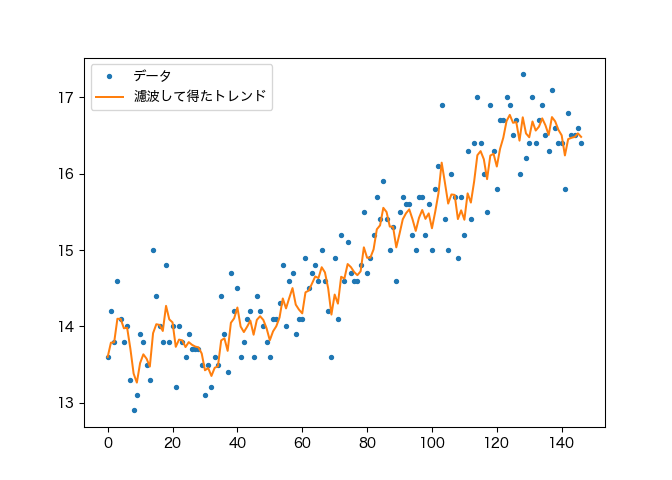1 シミュレーションのための粒子法
1.1 はじめに
多くの物質は元々離散的であり,その最小単位は原子や分子である.
これをコンピュータ内に粒子として表現し,その現実世界での動きを模倣することを目指すシミュレーション法は 分子動力学法 (MD: molecular dynamics) と呼ばれる.
アイデアは大変シンプルである.
1.2 分子動力学法
分子動力学法 の文脈で 粒子法 (particle methods) と言ったとき,
- 古典的な質点には Newton 力学
- 剛体で体積を持つ場合は Euler 方程式
- 内部構造を持つ場合は Langrange 方程式
- さらに一般の場合は Hamilton 方程式
に基づいて粒子の動きをシミュレーションすることを指す.
1.3 モンテカルロ法
分子動力学法は Monte Carlo 法と組み合わせて使われることが多い.
粒子の動きを上述の方程式に基づいて提案し,離散化誤差を Metropolis 法によって補正することで,系の物理量の分布を求めたり,平均値を求めたりする (Rapaport, 2004, p. 4), (Griebel et al., 2007, p. 17).
そもそも MCMC の手法 (Metropolis et al., 1953) 自体も,Schrödinger 方程式に基づいた基底状態のシミュレーションを実行するために生まれたものである.
これが強力なのである.極めて強力であるが故に,計算科学の分野ではすでに,そして将来的には確実に,シミュレーションと数値実験が,実際の実験と似たような重要な役割を科学において担うことになると見られている.
1.4 推論のための粒子法との関係
この意味での粒子法と,統計学において粒子法と言った場合に想像されるであろう SMC や IPM (interacting particle methods) とは 実は数理的には同一物である ことを見たい.
一言で言えば,一般に粒子法はポテンシャル(ハミルトニアン)に従って粒子を伝播する方法であり,粒子フィルターは特にこれが Feynman-Kac 測度で与えられる場合に用いられる粒子法である.
2 推論のための粒子法
2.1 ベイズ逆問題
シミュレーションができるようになったならば,これを実際の実験データや観測データと付き合わせて比較したいということになる.
このようにデータに基づいてシミュレーションを校正する作業は 逆問題 (inverse problem) と呼ばれ,旧来は統計的推論との関係は希薄であった.
しかし「系に対する,方程式などの形で与えられる事前知識をもとに,データから実際の構造に対する知識をアップデートしていく」という営みはまさにベイズ推論の一種である.
特にベイズによる取り扱いが統一的な数学的基礎を与えることに加え,従来からの無定義用語であった well-posedness に数学的に厳密な定義を与えることができることから,近年 ベイズ逆問題 (Bayesian inverse problem) と呼ばれる分野が進展を見せている (Stuart, 2010).
さらに従来の逆問題のためのアルゴリズムは統計学における対応物を持つことが多い.例えば Tikhonov-Phillips 正則化と呼ばれる手続きは Ridge 回帰 (Hoerl and Kennard, 1970) に他ならない.データ同化においては変分推論が先駆けて古くから使われている (Sasaki, 1958).
ベイズの取り扱いはこのようなアルゴリズムの開発に対しても統一的な基盤を与える上に,アルゴリズムの最適性の議論も可能になる (Nickl, 2017).
2.2 データ同化
極めて現代的な逆問題の発展形が データ同化 (data assimilation) または 動的逆問題 (dynamic inverse problem) である.2
データ同化は地球科学,特に気象予測の分野で芽生えた考え方である.気象予測では大規模なシミュレーションが欠かせないが,同時に正確な予測のためには初期値の正確さが重要であることがその黎明期から認識されていた (Kalnay, 2002).
しかし系が巨大すぎるあまり,観測データから得られる情報は極めて限定的であり,むしろ初期値を正確に知るためにもシミュレーションや構造的な知識が必要である.
このように順問題と逆問題とを逐次的に考えることがデータ同化の特徴である.もしかしたら data-simulation assimilation や data-model assimilation と呼ぶべきかもしれない.
現在データ同化は測定値とシミュレーションを同化させて精度の良い予測を行う営為全般に応用が進んでいる (Nakamura and Potthast, 2015).
2.3 EnKF
データ同化のダイナミックな問題設定が制御理論に近く,Kalman フィルター (Kalman, 1960) が利用可能であることが 1980 年代に自覚された (Ghil et al., 1981).
しかし数値気象予測では状態空間が極めて高次元であり,計算コストの削減が必要であった.
アンサンブルカルマンフィルター (EnKF: Ensemble Kalman Filter) (Evensen, 1994) はデータ同化の 2024 時点でもデファクトスタンダードである.
2.4 変分法
(Sasaki, 1958) など黎明期から変分法の応用が考えられていた.
この方法は (Lions, 1971) で最適制御の 随伴法 (adjoint method) (Pontryagin et al., 1962) と合流し,3D-VAR, 4D-VAR などの手法が提案されている (Talagrand and Courtier, 1987).
2.5 粒子フィルターの位置付け
従来から粒子法が用いられていたが,粒子フィルターは今後の大規模データ世界におけるデータ同化の主力技術と目されている (Leeuwen et al., 2019).
例えば気象予測の分野で,積雲対流 (cumulus convection) という現象は数 km のスケールで起こるが,大気循環の全体の記述に不可欠であることが知られている (浅井冨雄, 1967).
これを観測する数 km 解像度の convective scale でのデータ同化は従来の \(10^4\) オーダーでの 総観スケール (synoptic scale) でのデータ同化よりもはるかに非線型性が強いため,従来法の革新が迫れられており (Yano et al., 2018),粒子フィルターが注目されている.
関連記事
References
Footnotes
「MRI や PET では脳内における血流量や糖代謝等の空間分布が mm オーダーの分解能で直接に計測できるのに対し、EEG や MEG では頭表面上で計測される電位分布や磁場分布から脳内の起電力分布を推定するという問題、いわゆる脳電位逆問題や脳磁場逆問題を解決しなければならない。」(岡本良夫 and 本間生夫, 2002).fMRI や陽電子断層撮像法 (PET: Positron Emission Tomography) (Ter-Pogossian et al., 1975) は深いところまで見れるが時間分解能が低いという欠点もある.↩︎
データ同化に対するレトロニムとして,逆問題を 古典的逆問題 (classical inverse problem) と呼ぶこともある (Nakamura and Potthast, 2015, pp. 1–5).↩︎


